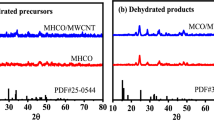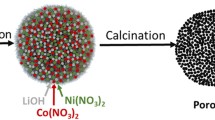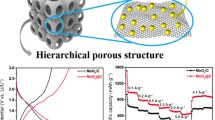Abstract
Undoubtedly, there remains an urgent prerequisite to achieve significant advances in both the specific capacity and cyclability of Li-O2 batteries for their practical application. In this work, a series of unique three-dimensional (3D) α-MnO2/MWCNTs hybrids are successfully prepared using a facile lyophilization method and investigated as the cathode of Li-O2 batteries. Thereinto, cross-linked α-MnO2/MWCNTs nanocomposites are first synthesized via a modified chemical route. Results demonstrate that MnO2 nanorods in the nanocomposites have a length of 100–400 nm and a diameter ranging from 5 to 10 nm, and more attractively, the as-lyophilized 3D MnO2/MWCNTs hybrids is uniquely constructed with large amounts of interconnected macroporous channels. The Li-O2 battery with the 3D macroporous hybrid cathode that has a mass percentage of 50% of α-MnO2 delivers a high discharge specific capacity of 8,643 mAh·g−1 at 100 mA·g−1, and maintains over 90 cycles before the discharge voltage drops to 2.0 V under a controlled specific capacity of 1,000 mAh·g−1. It is observed that when being recharged, the product of toroidal Li2O2 particles disappears and electrode surfaces are well recovered, thus confirming a good reversibility. The excellent performance of Li-O2 battery with the 3D α-MnO2/MWCNTs macroporous hybrid cathode is ascribed to a synergistic combination between the unique macroporous architecture and highly efficient bi-functional α-MnO2/MWCNTs electrocatalyst.

Similar content being viewed by others
References
Abraham, K. M.; Jiang, Z. A polymer electrolyte-based rechargeable lithium/oxygen battery. J. Electrochem. Soc. 1996, 143, 1–5.
Girishkumar, G.; McCloskey, B.; Luntz, A. C.; Swanson, S.; Wilcke, W. Lithium-air battery: Promise and challenges. J. Phys. Chem. Lett. 2010, 1, 2193–2203.
Bruce, P. G.; Freunberger, S. A.; Hardwick, L. J.; Tarascon, J. M. Li-O2 and Li-S batteries with high energy storage. Nat. Mater. 2012, 11, 19–29.
Cheng, F. Y.; Chen, J. Lithium-air batteries: Something from nothing. Nat. Chem. 2012, 4, 962–963.
Zhu, Y. Q.; Cao, T.; Li, Z.; Chen, C.; Peng, Q.; Wang, D. S.; Li, Y. D. Two-dimensional SnO2/graphene heterostructures for highly reversible electrochemical lithium storage. Sci. China Mater. 2018, in press, DOI: 10.1007/s40843-018-9324-0.
Park, M.; Sun, H.; Lee, H.; Lee, J.; Cho, J. Lithium-air batteries: Survey on the current status and perspectives towards automotive applications from a battery industry standpoint. Adv. Energy Mater. 2012, 2, 780–800.
Kwabi, D. G.; Ortiz-Vitoriano, N.; Freunberger, S. A.; Chen, Y. H.; Imanishi, N.; Bruce, P. G.; Shao-Horn, Y. Materials challenges in rechargeable lithium-air batteries. MRS Bull. 2014, 39, 443–452.
McCloskey, B. D.; Bethune, D. S.; Shelby, R. M.; Mori, T.; Scheffler, R.; Speidel, A.; Sherwood, M.; Luntz, A. C. Limitations in rechargeability of Li-O2 batteries and possible origins. J. Phys. Chem. Lett. 2012, 3, 3043–3047.
Lu, Y.-C.; Kwabi, D. G.; Yao, K. P.; Harding, J. R.; Zhou, J. G.; Zuin, L.; Shao-Horn, Y. The discharge rate capability of rechargeable Li–O2 batteries. Energy Environ. Sci. 2011, 4, 2999–3007.
Radin, M. D.; Rodriguez, J. F.; Tian, F.; Siegel, D. J. Lithium peroxide surfaces are metallic, while lithium oxide surfaces are not. J. Am. Chem. Soc. 2012, 134, 1093–1103.
Wang, J. J.; Li, Y. L.; Sun, X. L. Challenges and opportunities of nanostructured materials for aprotic rechargeable lithium–air batteries. Nano Energy 2013, 2, 443–467.
Wang, Y.; Cho, S. C. Analysis of air cathode performance for lithium-air batteries. J. Electrochem. Soc. 2013, 160, A1847–A1855.
Lu, Y. C.; Gasteiger, H. A.; Parent, M. C.; Chiloyan, V.; Shao-Horn, Y. The influence of catalysts on discharge and charge voltages of rechargeable Li-oxygen batteries. Electrochem. Solid-State Lett. 2010, 13, A69–A72.
Li, F. J.; Zhang, T.; Zhou, H. S. Challenges of non-aqueous Li-O2 batteries: Electrolytes, catalysts, and anodes. Energy Environ. Sci. 2013, 6, 1125–1141.
Shao, Y. Y.; Ding, F.; Xiao, J.; Zhang, J.; Xu, W.; Park, S.; Zhang, J. G.; Wang, Y.; Liu, J. Making Li-air batteries rechargeable: Material challenges. Adv. Funct. Mater. 2013, 23, 987–1004.
Lu, Y.-C.; Xu, Z. C.; Gasteiger, H. A.; Chen, S.; Hamad-Schifferli, K.; Shao-Horn, Y. Platinum-gold nanoparticles: A highly active bifunctional electrocatalyst for rechargeable lithium-air batteries. J. Am. Chem. Soc. 2010, 132, 12170–12171.
Lu, Y. C.; Gasteiger, H. A.; Shao-Horn, Y. Catalytic activity trends of oxygen reduction reaction for nonaqueous Li-air batteries. J. Am. Chem. Soc. 2011, 133, 19048–19051.
Xu, J. J.; Wang, Z. L.; Xu, D.; Zhang, L. L.; Zhang, X. B. Tailoring deposition and morphology of discharge products towards high-rate and long-life lithium-oxygen batteries. Nat. Commun. 2013, 4, 2438.
Jung, H. G.; Jeong, Y. S.; Park, J. B.; Sun, Y.-K.; Scrosati, B.; Lee, Y. J. Ruthenium-based electrocatalysts supported on reduced graphene oxide for lithium-air batteries. ACS Nano 2013, 7, 3532–3539.
Lu, J.; Lee, Y. J.; Luo, X. Y.; Lau, K. C.; Asadi, M.; Wang, H. H.; Brombosz, S.; Wen, J. G.; Zhai, D. Y.; Chen, Z. H. et al. A lithium-oxygen battery based on lithium superoxide. Nature 2016, 529, 377–382.
Park, J.; Jun, Y. S.; Lee, W. R.; Gerbec, J. A.; See, K. A.; Stucky, G. D. Bimodal mesoporous titanium nitride/carbon microfibers as efficient and stable electrocatalysts for Li-O2 batteries. Chem. Mater. 2013, 25, 3779–3781.
Kwak, W. J.; Lau, K. C.; Shin, C. D.; Amine, K.; Curtiss, L. A.; Sun, Y. K. A Mo2C/Carbon nanotube composite cathode for lithium-oxygen batteries with high energy efficiency and long cycle life. ACS Nano 2015, 9, 4129–4137.
Zhang, K. J.; Zhang, L. X.; Chen, X.; He, X.; Wang, X. G.; Dong, S. M.; Han, P. X.; Zhang, C. J.; Wang, S.; Gu, L. et al. Mesoporous cobalt molybdenum nitride: A highly active bifunctional electrocatalyst and its application in lithium-O2 batteries. J. Phys. Chem. C 2013, 117, 858–865.
Li, Q.; Xu, P.; Zhang, B.; Tsai, H.; Wang, J.; Wang, H. L.; Wu, G. One-step synthesis of Mn3O4/reduced graphene oxide nanocomposites for oxygen reduction in nonaqueous Li-O2 batteries. Chem. Commun. 2013, 49, 10838–10840.
Zhang, J.; Lyu, Z.; Zhang, F.; Wang, L. J.; Xiao, P.; Yuan, K. D.; Lai, M.; Chen, W. Facile synthesis of hierarchical porous Mn3O4 nanoboxes as efficient cathode catalysts for Li-O2 batteries. J. Mater. Chem. A 2016, 4, 6350–6356.
Wang, H. L.; Yang, Y.; Liang, Y. Y.; Zheng, G. Y.; Li, Y. G.; Cui, Y.; Dai, H. J. Rechargeable Li-O2 batteries with a covalently coupled MnCo2O4-graphene hybrid as an oxygen cathode catalyst. Energy Environ. Sci. 2012, 5, 7931–7935.
Cao, Y.; Cai, S. R.; Fan, S. C.; Hu, W. Q.; Zheng, M. S.; Dong, Q. F. Reduced graphene oxide anchoring CoFe2O4 nanoparticles as an effective catalyst for non-aqueous lithium-oxygen batteries. Faraday Discuss. 2014, 172, 215–221.
Yang, Y.; Shi, M.; Li, Y. S.; Fu, Z. W. MnO2-graphene composite air electrode for rechargeable Li-air batteries. J. Electrochem. Soc. 2012, 159, A1917–A1921.
Liu, S. Y.; Zhu, Y. G.; Xie, J.; Huo, Y.; Yang, H. Y.; Zhu, T. J.; Cao, G. S.; Zhao, X. B.; Zhang, S. C. Direct growth of flower-like α-MnO2 on threedimensional graphene for high-performance rechargeable Li-O2 batteries. Adv. Energy Mater. 2014, 4, 1301960.
Song, K.; Jung, J.; Heo, Y. U.; Lee, Y. C.; Cho, K.; Kang, Y. M. α-MnO2 nanowire catalysts with ultra-high capacity and extremely low overpotential in lithium-air batteries through tailored surface arrangement. Phys. Chem. Chem. Phys. 2013, 15, 20075.
Débart, A.; Paterson, A. J.; Bao, J. L.; Bruce, P. G. α-MnO2 nanowires: A catalyst for the O2 electrode in rechargeable lithium batteries. Angew. Chem. 2008, 120, 4597–4600.
Cao, Y.; Wei, Z. K.; He, J.; Zang, J.; Zhang, Q.; Zheng, M. S.; Dong, Q. F. α-MnO2 nanorods grown in situ on graphene as catalysts for Li-O2 batteries with excellent electrochemical performance. Energy Environ. Sci. 2012, 5, 9765–9768.
Salehi, M.; Shariatinia, Z. An optimization of MnO2 amount in CNT-MnO2 nanocomposite as a high rate cathode catalyst for the rechargeable Li-O2 batteries. Electrochim. Acta 2016, 188, 428–440.
Liu, C.; Li, F.; Ma, L. P.; Cheng, H. M. Advanced materials for energy storage. Adv. Mater. 2010, 22, E28–E62.
Yang, X. H.; He, P.; Xia, Y. Y. Preparation of mesocellular carbon foam and its application for lithium/oxygen battery. Electrochem. Commun. 2009, 11, 1127–1130.
Xiao, J.; Mei, D. H.; Li, X. L.; Xu, W.; Wang, D. Y.; Graff, G. L.; Bennett, W. D.; Nie, Z. M.; Saraf, L. V.; Aksay, I. A. et al. Hierarchically porous graphene as a lithium-air battery electrode. Nano Lett. 2011, 11, 5071–5078.
Chen, S.; Zhu, J. W.; Han, Q. F.; Zheng, Z. J.; Yang, Y.; Wang, X. Shapecontrolled synthesis of one-dimensional MnO2 via a facile quick-precipitation procedure and its electrochemical properties. Cryst. Growth Des. 2009, 9, 4356–4361.
Chen, S.; Zhu, J. W.; Wu, X. D.; Han, Q. F.; Wang, X. Graphene oxide-MnO2 nanocomposites for supercapacitors. ACS Nano 2010, 4, 2822–2830.
Lim, H. D.; Park, K. Y.; Song, H.; Jang, E. Y.; Gwon, H.; Kim, J.; Kim, Y. H.; Lima, M. D.; Robles, R. O.; Lepró, X. et al. Enhanced power and rechargeability of a Li-O2 battery based on a hierarchical-fibril CNT electrode. Adv. Mater. 2013, 25, 1348–1352.
Tu, Y. C.; Li, H. B.; Deng, D. H.; Xiao, J. P.; Cui, X. J.; Ding, D.; Chen, M. S.; Bao, X. H. Low charge overpotential of lithium-oxygen batteries with metallic Co encapsulated in single-layer graphene shell as the catalyst. Nano Energy 2016, 30, 877–884.
McCloskey, B. D.; Speidel, A.; Scheffler, R.; Miller, D. C.; Viswanathan, V.; Hummelshoj, J. S.; Norskov, J. K.; Luntz, A. C. Twin problems of interfacial carbonate formation in nonaqueous Li-O2 batteries. J. Phys. Chem. Lett. 2012, 3, 997–1001.
Peng, Z. Q.; Freunberger, S. A.; Chen, Y. H.; Bruce, P. G. A reversible and higher-rate Li-O2 battery. Science 2012, 337, 563–566.
Thotiyl, M. M. O.; Freunberger, S. A.; Peng, Z. Q.; Chen, Y. H.; Liu, Z.; Bruce, P. G. A stable cathode for the aprotic Li-O2 battery. Nat. Mater. 2013, 12, 1050–1056.
Lau, S.; Archer, L. A. Nucleation and growth of lithium peroxide in the Li-O2 battery. Nano Lett. 2015, 15, 5995–6002.
Yang, C. Z.; Wong, R. A.; Hong, M. S.; Yamanaka, K.; Ohta, T.; Byon, H. R. Unexpected Li2O2 film growth on carbon nanotube electrodes with CeO2 nanoparticles in Li-O2 batteries. Nano Lett. 2016, 16, 2969–2974.
Aetukuri, N. B.; McCloskey, B. D.; García, J. M.; Krupp, L. E.; Viswanathan, V.; Luntz, A. C. Solvating additives drive solution-mediated electrochemistry and enhance toroid growth in non-aqueous Li-O2 batteries. Nat. Chem. 2015, 7, 50–56.
Zhong, L.; Mitchell, R. R.; Liu, Y.; Gallant, B. M.; Thompson, C. V.; Huang, J. Y.; Mao, S. X.; Shao-Horn, Y. In situ transmission electron microscopy observations of electrochemical oxidation of Li2O2. Nano Lett. 2013, 13, 2209–2214.
Acknowledgements
This work was supported by the National Basic Research Program of China (973) (Nos. 2014CB932300 and 2014CB932303), the National Key Research and Development Program of China (No. 2016YFB0101201), and the National Natural Science Foundation of China (Nos. 21533005 and 21503134).
Author information
Authors and Affiliations
Corresponding author
Electronic supplementary material
Rights and permissions
About this article
Cite this article
Shen, S., Wu, A., Xia, G. et al. Facile preparation of unique three-dimensional (3D) α-MnO2/MWCNTs macroporous hybrid as the high-performance cathode of rechargeable Li-O2 batteries. Nano Res. 12, 69–75 (2019). https://doi.org/10.1007/s12274-018-2182-x
Received:
Revised:
Accepted:
Published:
Issue Date:
DOI: https://doi.org/10.1007/s12274-018-2182-x




